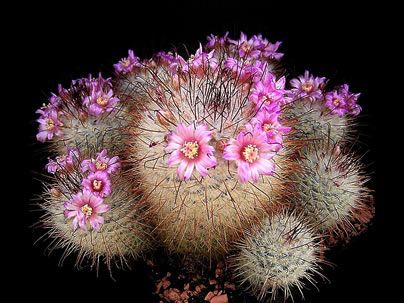The Silken Pincushion cactus (Mammillaria bombycina) is one of the most popular species among collectors. Native to Mexico, it is characterized by its densely clustered stems. The stems are cylindrical to globular, forming a charming set of “little balls.” Succulent and green in color, they have no leaves, and their tubercles are conical to cylindrical. Around the apex of each tubercle, there are dozens of white spines or hairs, giving this cactus a woolly appearance.
At the very top of the tubercle, we can see about four longer spines, brown in color and hook-shaped. It blooms in spring, displaying a circumference of funnel-shaped flowers on each branch, generally pink in color, but they can also be carmine or white. After pollination, berry-like fruits form, greenish-pink in color.

The shapes and textures of cacti and succulents are always very enchanting. In M. bombycina, it is no different. It is an essential species for those who are fond of these plants and can also be cultivated by beginner gardeners who want to try their hand at cacti, as they tend to be easy to care for.
Use M. bombycina in the composition of rock and arid-effect gardens. They are an excellent choice for locations with limited water availability. They like slightly inclined areas, which favor drainage. They can also be planted in pots and window boxes, decorating well-lit indoor environments.
The Silken Pincushion cactus should be cultivated in full sun, partial shade, or diffuse light, in substrates suitable for cacti and succulents, i.e., perfectly drainable and airy, and watered at spaced intervals. Suspend watering in winter. Excessive watering or substrate drainage deficiency (which can occur over time due to compaction) will cause rapid rotting of the roots and stems of this succulent.
It is tolerant of temperatures above 4°C (39°F). It does not withstand snow or frost. For a denser and more spiny formation, prefer cultivation under full sun. It propagates easily by seeds or by separating the new branches formed around the plant.


